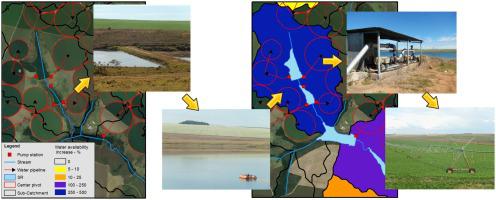当前位置:
X-MOL 学术
›
Agric. Water Manag.
›
论文详情
Our official English website, www.x-mol.net, welcomes your
feedback! (Note: you will need to create a separate account there.)
Modelling the impact of on-farm reservoirs on dry season water availability in an agricultural catchment area of the Brazilian savannah
Agricultural Water Management ( IF 5.9 ) Pub Date : 2020-11-01 , DOI: 10.1016/j.agwat.2020.106296 Filipe Sampaio Casulari Pinhati , Lineu Neiva Rodrigues , Saulo Aires de Souza
Agricultural Water Management ( IF 5.9 ) Pub Date : 2020-11-01 , DOI: 10.1016/j.agwat.2020.106296 Filipe Sampaio Casulari Pinhati , Lineu Neiva Rodrigues , Saulo Aires de Souza

|
Abstract The Sao Marcos catchment (SAM) encompasses one of the largest center pivot areas in the Southern Hemisphere. Irrigation at SAM is highly dependent on small on-farm reservoirs (SR), specifically at the headwater sub-catchments, where large center pivot irrigation areas are evident. However, the capacity and hydrological performance of those SR are largely unknown as their hydrological characteristics have not been widely assessed. The objective of this work was to establish a method to assess the impact of the SR network over dry season water availability at SAM. For this purpose, a model was developed to test the hypothesis that SR increase water availability at the local, sub-catchment and catchment scales. To this end, SR were mapped with sub-metric satellite images, and their volumes estimated by linear regression with other on-farm reservoirs with known volumes. Streamflow based on four gauged historical data was regionalized in a monthly time step for 4161 sub-catchments. Subsequently, SR were modelled individually, at the local scale, and as a group both at the sub-catchment scale (medium scale) and at the catchment scale (broad scale) in scenarios using Q95 and mean inflows. Results showed that remotely sensed surface area at full supply level (FSL) is the factor that caused the largest variation in the outputs, which has direct correlation with the upstream drainage area discharging to each SR. Simulations suggested that the combination of SR storage capacities have a high proportional impact in increasing water availability at headwater sub-catchments. However, the capacity of a single SR to augment local water availability is more pronounced when its upstream drainage area is 3 km² or greater. Furthermore, assuming there are no inflows of water during the dry season, a single SR must have a minimum FSL of 0.08 ha to result in any improvement in local water availability.
中文翻译:

模拟农场水库对巴西大草原农业集水区旱季可用水量的影响
摘要 圣马科斯流域 (SAM) 包括南半球最大的中心枢纽区之一。SAM 的灌溉高度依赖小型农场水库 (SR),特别是在源头子集水区,那里的大型中心枢轴灌溉区很明显。然而,这些 SR 的容量和水文性能在很大程度上是未知的,因为它们的水文特征尚未得到广泛评估。这项工作的目的是建立一种方法来评估 SR 网络对 SAM 旱季可用水量的影响。为此,开发了一个模型来检验 SR 增加当地、子流域和流域尺度的可用水量的假设。为此,SR 被映射到亚度量卫星图像,以及它们的体积通过线性回归与其他已知体积的农场水库进行估计。4161 个子流域以每月时间步长为基础对基于四个测量历史数据的流量进行了区域化。随后,在使用 Q95 和平均流入量的情景中,SR 在局部尺度上单独建模,并在子流域尺度(中等尺度)和流域尺度(大尺度)作为一个组进行建模。结果表明,全供应水平 (FSL) 的遥感表面积是导致输出变化最大的因素,这与向每个 SR 排放的上游流域面积直接相关。模拟表明,SR 存储容量的组合对增加源头子集水区的可用水量有很大的影响。然而,当上游流域面积为 3 平方公里或更大时,单个 SR 增加当地可用水量的能力更为明显。此外,假设在旱季没有水流入,单个 SR 的最低 FSL 必须为 0.08 公顷,才能改善当地的可用水量。
更新日期:2020-11-01
中文翻译:

模拟农场水库对巴西大草原农业集水区旱季可用水量的影响
摘要 圣马科斯流域 (SAM) 包括南半球最大的中心枢纽区之一。SAM 的灌溉高度依赖小型农场水库 (SR),特别是在源头子集水区,那里的大型中心枢轴灌溉区很明显。然而,这些 SR 的容量和水文性能在很大程度上是未知的,因为它们的水文特征尚未得到广泛评估。这项工作的目的是建立一种方法来评估 SR 网络对 SAM 旱季可用水量的影响。为此,开发了一个模型来检验 SR 增加当地、子流域和流域尺度的可用水量的假设。为此,SR 被映射到亚度量卫星图像,以及它们的体积通过线性回归与其他已知体积的农场水库进行估计。4161 个子流域以每月时间步长为基础对基于四个测量历史数据的流量进行了区域化。随后,在使用 Q95 和平均流入量的情景中,SR 在局部尺度上单独建模,并在子流域尺度(中等尺度)和流域尺度(大尺度)作为一个组进行建模。结果表明,全供应水平 (FSL) 的遥感表面积是导致输出变化最大的因素,这与向每个 SR 排放的上游流域面积直接相关。模拟表明,SR 存储容量的组合对增加源头子集水区的可用水量有很大的影响。然而,当上游流域面积为 3 平方公里或更大时,单个 SR 增加当地可用水量的能力更为明显。此外,假设在旱季没有水流入,单个 SR 的最低 FSL 必须为 0.08 公顷,才能改善当地的可用水量。











































 京公网安备 11010802027423号
京公网安备 11010802027423号